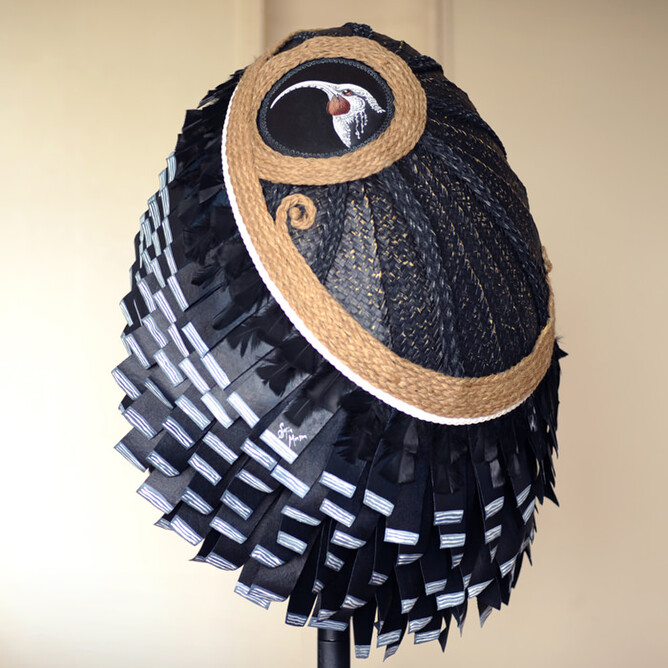The hunt begins! The 2015 Big Egg Hunt is here in New Zealand for the second year in a row in support of the Starship Foundation and I've created a brand new artwork for the event.
"Huia and the Twelve Heavens" is part sculpture, part painting, part contemporary Maori cloak... whatever it is, watch the artwork taking shape in my studio in this video...
Own this artwork!!
"Huia and the Twelve Heavens" is up for auction with all proceeds going to the Starship Foundation. You can place your bid at www.trademe.co.nz/art/carvings-sculpture/other/auction-858131198.htm. The auction closes Tuesday 07 April 2015 at 7:40pm.
Get involved in the Big Egg Hunt
100 giant eggs designed by top New Zealand artists are hidden throughout Auckland, Wellington and Christchurch in historic, landmark and public spaces. Take your friends and family out to hunt for the eggs and once you find them, take photos of yourselves with the sculptures and upload them onto Instagram to play this interactive, nationwide game. Visit www.thebigegghunt.co.nz for more details on how to join the hunt this Easter.
About Sofia Minson's Artwork "Huia and the Twelve Heavens"
Throughout her 11 year career Minson has predominantly painted large-scale, detailed oil portraits and landscapes. However more recently the Auckland artist of mixed Maori, Swedish, English and Irish ancestry has been fusing painting with traditional Asian and Pacific garment and art-making materials, particularly of Maori feather cloaks. This egg, "Huia and the Twelve Heavens, links concepts from ancient Maori cosmology with Hindu mandala symbols and New Zealand's extinct native huia bird.
In Maori culture, Manu Huia (Huia Birds) were not normally eaten but were rare birds treasured for their precious plumes, worn by people of high rank. Although its habitat was restricted to the southern North Island, the huia’s tail feathers spread throughout the land because they were valued highly and were given as gifts among tribes to show great respect or exchanged for other valuable goods such as pounamu. The feathers were stored in intricately carved boxes called Waka Huia.
A huia has twelve feathers in its tail fan, like many perching birds. To our Maori ancestors, each tail feather of the Manu Huia was treasured as it represented one of the twelve heavens of Io, the Supreme Being, in Maori cosmology. The myth inspiring this artwork speaks of the Huia’s journey through the twelve heavens and back again and how he earned his white tipped tail feathers....
The Story of Manutea (White bird) and Te Manu Huia (Huia Bird)
Time had come for Taane, god of the forest and progenitor of mankind, to make his ascent to the 12 heavens to receive the baskets of knowledge. In order to deliver this most important message to Taane, Rehua who was an ancestral atua (god) residing in the heavens took from his own head a humble bird, pure white in colour, called Manutea. Rehua gave Manutea instructions to travel from Te Toi o Nga Rangi (The Summit of The Heavens) down through the 12 heavens to Papatuanuku (Earth).
When Manutea got to earth, he had to find the highest mountain on earth called Maunganui (Great Mountain). He became lost and asked Te Whanau Puhi (The Wind Children) for directions to Maunganui. The Wind Children told Manutea, the highest mountain that you are actually looking for is Maunga Tea. So Manutea found Maungatea and it was here that Taane was summoned to receive the karere (message) from Rehua that Io Matua Kore (Io the Parentless who was always existent without beginning or end) wanted Taane to climb the heavens and retrieve the sacred wananga (baskets of knowledge).
Taane told Manutea that he officially accepted the message and would make his way to Te Puhi o Nga Rangi Tuhaha (The Summit of the Heavens). Satisfied, Manutea returned to Te Toi o Nga Rangi (First heavens) to Rehua. As a gift to Manutea, Rehua transformed his tinana (body) to black to represent Te Kore (The Void) and his journey through the 12 heavens. Rehua added more feathers to his tail to make 12 in total and left the white tips to mark the 12 heavens. Manutea was given a new name to go along with the new look - Manu Huia or the Huia Bird. As Rehua was transforming Manutea he recited a special chant:
Ko te tangi a te manu
Hui, hui, hui hui mai
Huia i runga
Huia i raro
Huia i roto
Huia i waho
Huia te muka tangata mai Hawaiki
Posted by artist Sofia Minson from NewZealandArtwork.com
New Zealand Maori portrait and landscape oil painting


